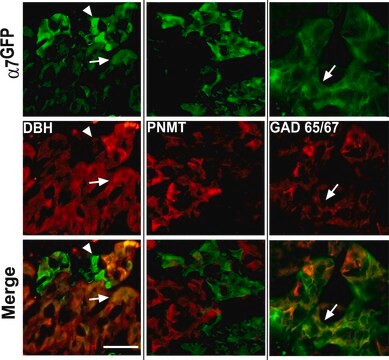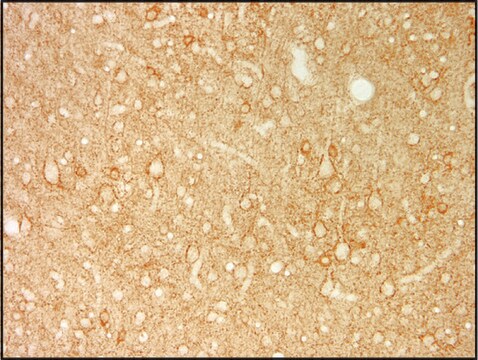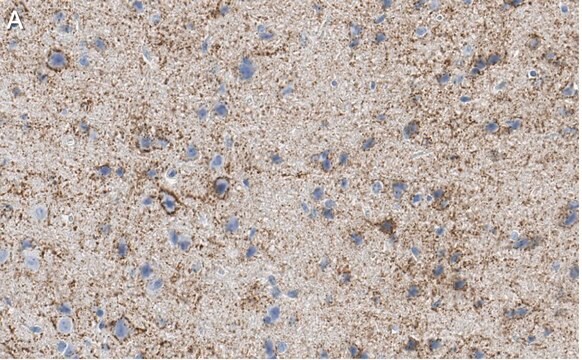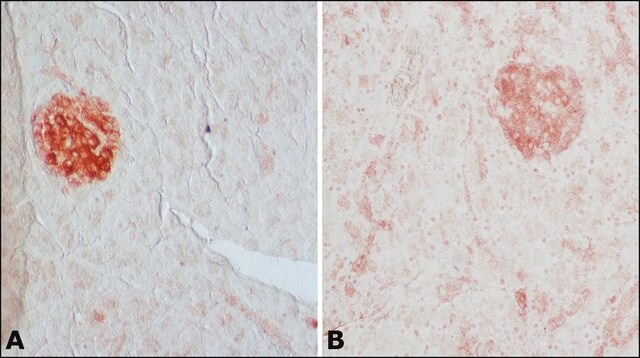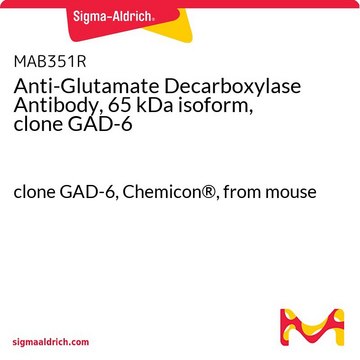MAB351
Anti-Glutamate Decarboxylase Antibody, 65 kDa isoform, clone GAD-6
clone GAD-6, Chemicon®, from mouse
Sinonimo/i:
GAD65
About This Item
Prodotti consigliati
Origine biologica
mouse
Livello qualitativo
Forma dell’anticorpo
purified immunoglobulin
Tipo di anticorpo
primary antibodies
Clone
GAD-6, monoclonal
Reattività contro le specie
rat, human
Produttore/marchio commerciale
Chemicon®
tecniche
immunohistochemistry: suitable
western blot: suitable
Isotipo
IgG2a
N° accesso NCBI
N° accesso UniProt
Condizioni di spedizione
dry ice
modifica post-traduzionali bersaglio
unmodified
Informazioni sul gene
human ... GAD2(2572)
Descrizione generale
Specificità
Immunogeno
Applicazioni
Western blot
Optimal working dilutions must be determined by end user.
APPLICATION NOTES FOR MAB351
IMMUNOHISTOCHEMISTRY
1) Perfuse rats with 100 mM phosphate buffer, pH 7.4 containing 1% paraformaldehyde, 0.34% L-lysine and 0.05% m-periodate (1% PLP).
2) Postfix brains in 1% PLP for 1-2 hours.
3) Transfer brains to 100 mM phosphate buffer containing 30% sucrose and gently agitate on a shaker platform at +4°C for 48-60 hours.
4) Using a sliding microtome, cut 30 mm sections of frozen cerebellum. As the sections are cut, collect them in a vial of cold 100 mM phosphate buffer.
5) Incubate sections in PBS containing 1.5% normal serum and 0.2% Triton X-100 for 30 minutes.
6) On a shaker platform, incubate sections with MAB351 (diluted 1 μg/mL in PBS containing 1.5% normal serum and 0.2% Triton X-100) for 12-36 hours at +4°C.
7) On a shaker platform, rinse sections eight times, 10-15 minutes per rinse, in PBS.
8) Detect with standard secondary antibody detection system (PAP, ABC, etc.).
9) Mount sections, dehydrate, and apply coverslips.
Neuroscience
Neurotransmitters & Receptors
Descrizione del bersaglio
Stato fisico
Stoccaggio e stabilità
Risultati analitici
Rat brain tissue
human brain lysate
Altre note
Note legali
Esclusione di responsabilità
Non trovi il prodotto giusto?
Prova il nostro Motore di ricerca dei prodotti.
Raccomandato
Avvertenze
Warning
Indicazioni di pericolo
Consigli di prudenza
Classi di pericolo
Acute Tox. 4 Dermal - Acute Tox. 4 Inhalation - Acute Tox. 4 Oral - Aquatic Chronic 3
Codice della classe di stoccaggio
13 - Non Combustible Solids
Classe di pericolosità dell'acqua (WGK)
WGK 3
Punto d’infiammabilità (°F)
Not applicable
Punto d’infiammabilità (°C)
Not applicable
Certificati d'analisi (COA)
Cerca il Certificati d'analisi (COA) digitando il numero di lotto/batch corrispondente. I numeri di lotto o di batch sono stampati sull'etichetta dei prodotti dopo la parola ‘Lotto’ o ‘Batch’.
Possiedi già questo prodotto?
I documenti relativi ai prodotti acquistati recentemente sono disponibili nell’Archivio dei documenti.
Il team dei nostri ricercatori vanta grande esperienza in tutte le aree della ricerca quali Life Science, scienza dei materiali, sintesi chimica, cromatografia, discipline analitiche, ecc..
Contatta l'Assistenza Tecnica.
